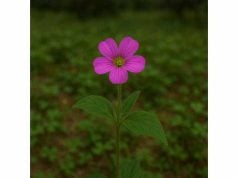Dolichos is a fascinating genus of leguminous plants that has long been celebrated for its nutritional, medicinal, and agricultural significance. Commonly known for species such as Dolichos lablab (often referred to as hyacinth bean or lablab bean), these plants are widely cultivated in tropical and subtropical regions across Asia, Africa, and the Americas. Renowned for their attractive, lush foliage and vibrant, bean-bearing pods, Dolichos species not only serve as an important source of protein and fiber in many traditional diets but are also valued for their potential therapeutic properties in traditional medicine. Modern research is increasingly uncovering the health-promoting benefits of Dolichos, revealing its potent antioxidant, anti-inflammatory, and metabolic regulatory effects. As a versatile crop used for food, fodder, and medicinal purposes, Dolichos plays a vital role in sustainable agriculture and natural health practices.
- Provides rich nutritional benefits including proteins, vitamins, and fiber.
- Exhibits potent antioxidant and anti-inflammatory properties.
- Supports metabolic health and aids in blood sugar regulation.
- Offers potential therapeutic benefits in traditional and modern medicine.
- Plays an important role in sustainable agriculture and soil enrichment.
Table of Contents
- Dolichos Botanical Profile and Distinctive Characteristics
- Dolichos Historical Legacy and Cultural Significance
- Dolichos Phytochemical Profile and Active Compounds
- Dolichos Health Benefits and Therapeutic Properties
- Dolichos Uses, Applications, and Safety Considerations
- Dolichos Recent Research and Scientific Insights
- Dolichos Frequently Asked Questions and Expert Answers
Dolichos Botanical Profile and Distinctive Characteristics
Dolichos is a genus within the Fabaceae (legume) family, renowned for its robust climbing or bushy growth habit and its ability to produce edible beans. These plants are characterized by their trifoliate or pinnate leaves, strikingly vibrant flowers, and pods that mature into a rich source of protein and other essential nutrients. Typically found in tropical and subtropical regions, Dolichos species adapt well to various soil types and environmental conditions, making them a staple crop in many parts of the world.
Morphological Features
- Leaves:
Dolichos plants often have compound leaves, which may be trifoliate or pinnate. The leaves are typically a deep, glossy green, providing an attractive contrast to the plant’s colorful flowers. Their structure allows for efficient photosynthesis even under high-light conditions. - Stems and Growth Habit:
Depending on the species, Dolichos can either climb on supports using tendrils or form bushy, self-supporting shrubs. This adaptability allows them to be used in a variety of cultivation systems—from vertical trellising in home gardens to ground cover in agricultural fields. - Flowers:
The flowers of Dolichos are usually large, showy, and display an array of colors ranging from purples and blues to white and yellow. These vibrant blooms are not only visually appealing but also attract a wide range of pollinators, including bees and butterflies, which are essential for the plant’s reproduction. - Pods and Seeds:
Following the flowering phase, Dolichos produces elongated pods that contain numerous seeds. These pods mature to a characteristic brown or green hue and, once dried, release seeds that are rich in proteins, carbohydrates, and various micronutrients. The seeds serve as a vital food source in many traditional diets and are also used for animal feed.
Ecological Adaptations
Dolichos species exhibit several ecological adaptations that contribute to their resilience:
- Drought and Heat Tolerance:
Many species within the Dolichos genus are adapted to withstand periods of drought and high temperatures. Their deep root systems allow them to access water from lower soil layers, while their waxy leaf coatings minimize water loss. - Soil Enrichment:
As legumes, Dolichos plants have the ability to fix atmospheric nitrogen through symbiotic relationships with rhizobia bacteria in their root nodules. This natural process enriches the soil, making Dolichos a valuable crop for sustainable agricultural practices and crop rotation systems. - Pollinator Attraction:
The colorful and fragrant flowers of Dolichos play a crucial role in attracting pollinators, which ensures successful cross-pollination and genetic diversity. This ecological interaction not only supports the plant’s reproductive success but also contributes to the overall health of the local ecosystem.
Distribution and Cultivation
Dolichos is predominantly cultivated in tropical and subtropical regions across Asia, Africa, and the Americas. It thrives in warm climates with well-drained soils and is often grown in mixed cropping systems. In many parts of the world, Dolichos is an essential crop that supports food security and local economies by providing a sustainable source of high-quality protein.
In summary, the botanical profile of Dolichos highlights its remarkable adaptability, nutritional value, and ecological significance. Its striking morphology, robust growth habit, and ability to improve soil fertility make it a key player in both traditional agriculture and modern sustainable farming practices.
Dolichos Historical Legacy and Cultural Significance
Dolichos has a rich historical legacy that spans centuries of agricultural and medicinal use. In many cultures, this versatile legume has been recognized not only as a nutritious food source but also as a plant with significant therapeutic potential. Traditional knowledge about Dolichos has been passed down through generations, reflecting its importance in both daily sustenance and holistic health practices.
Traditional Uses and Folk Medicine
- Nutritional Importance:
In regions where Dolichos is cultivated, it has traditionally been a staple food, providing essential proteins, carbohydrates, and vitamins. The seeds are often ground into flour or cooked as a vegetable, making them a vital component of local diets. - Medicinal Applications:
Traditional healers have long used various parts of Dolichos for their purported medicinal properties. Infusions, decoctions, and poultices made from Dolichos leaves, seeds, and pods have been employed to treat a range of ailments, including digestive disorders, inflammation, and fatigue. Its role in folk medicine underscores its value as a natural remedy for everyday health issues. - Cultural Symbolism:
Beyond its practical uses, Dolichos has also acquired symbolic significance in various cultures. It is often associated with nourishment, vitality, and prosperity due to its ability to enhance soil fertility through nitrogen fixation. In some traditions, Dolichos is celebrated in harvest festivals and other cultural rituals as a symbol of abundance and renewal.
Evolution of Cultivation Practices
Over time, the cultivation of Dolichos has evolved with advancements in agricultural techniques and a growing understanding of plant genetics. Traditional farming methods have been complemented by modern agricultural practices aimed at improving yield, disease resistance, and environmental sustainability. This evolution reflects the enduring importance of Dolichos as both a food crop and a medicinal plant.
Modern Cultural Relevance
Today, Dolichos continues to play a significant role in both traditional and contemporary contexts:
- Sustainable Agriculture:
With increasing emphasis on sustainable farming practices, Dolichos is recognized for its ability to improve soil health through nitrogen fixation. It is often integrated into crop rotation systems to enhance soil fertility and reduce the need for synthetic fertilizers. - Ethnobotanical Research:
Modern ethnobotanists are revisiting traditional uses of Dolichos to better understand its medicinal properties and cultural significance. This research not only validates ancient wisdom but also paves the way for the development of new, plant-based therapies. - Global Culinary Influence:
The nutritional value and versatility of Dolichos have earned it a place in modern culinary traditions. It is increasingly featured in health-conscious recipes and gourmet dishes, reflecting its continued relevance in both traditional and contemporary diets.
In essence, the historical legacy of Dolichos highlights its dual role as a vital food source and a revered medicinal plant. Its cultural significance is deeply rooted in its ability to sustain life, enrich soils, and promote health, making it an enduring symbol of natural abundance and well-being.
Dolichos Phytochemical Profile and Active Compounds
The health-promoting properties of Dolichos are closely linked to its rich phytochemical composition. Extensive research has revealed that this legume contains a variety of bioactive compounds that contribute to its nutritional value and medicinal potential. These compounds not only underpin its traditional uses but also offer exciting possibilities for modern therapeutic applications.
Key Bioactive Constituents
- Flavonoids:
Dolichos is abundant in flavonoids, which are known for their strong antioxidant properties. These compounds help neutralize free radicals, reduce oxidative stress, and protect cells from damage. Flavonoids also play a role in modulating inflammatory pathways, thereby contributing to overall health. - Phenolic Compounds:
Phenolic acids and related compounds found in Dolichos add to its antioxidant capacity. These substances have been associated with anti-carcinogenic properties and may help in the prevention of chronic diseases by protecting cellular structures from oxidative damage. - Tannins:
Tannins are present in various parts of the Dolichos plant and are known for their astringent properties. They help in wound healing by precipitating proteins to form a protective barrier over damaged tissues. Tannins also exhibit antimicrobial effects, further supporting the herb’s traditional use in healing. - Saponins:
Saponins are glycosides that contribute to the immunomodulatory and anti-inflammatory effects of Dolichos. They enhance the body’s natural defense mechanisms and may help regulate cholesterol levels, contributing to cardiovascular health. - Alkaloids:
Some Dolichos species contain alkaloids, which can have potent biological activities. Although these compounds must be handled with care due to their potential toxicity, they also contribute to the plant’s therapeutic effects, particularly in the context of pain management and anti-inflammatory responses.
Synergistic Effects
The therapeutic benefits of Dolichos are not the result of any single compound but rather the synergistic interactions among its various bioactive constituents. Together, these compounds create a robust network that:
- Enhances the antioxidant defense system.
- Modulates inflammatory responses to protect against chronic disease.
- Supports immune function and promotes overall cellular health.
- Contributes to cardiovascular protection and metabolic regulation.
Factors Influencing Phytochemical Composition
The concentration and composition of bioactive compounds in Dolichos can vary based on several factors:
- Environmental Conditions:
Soil type, climate, and altitude play significant roles in determining the levels of phytochemicals in Dolichos. Plants grown in more stressful conditions may produce higher concentrations of protective compounds. - Harvesting Time:
The stage of growth and the time of harvest can affect the phytochemical profile. Optimal harvesting times are crucial for maximizing the yield of beneficial compounds. - Processing and Extraction Methods:
The methods used to process and extract compounds from Dolichos can influence the stability and concentration of its bioactive constituents. Standardized techniques are essential for ensuring consistency and efficacy in Dolichos-based products. - Genetic Variation:
Genetic differences among various species and cultivars of Dolichos contribute to variability in phytochemical content. Selective breeding and genetic studies help identify strains with the highest levels of desired compounds.
Ongoing research in phytochemistry continues to uncover the intricate network of compounds in Dolichos, paving the way for standardized extracts that maximize its therapeutic potential.
Dolichos Health Benefits and Therapeutic Properties
Dolichos has been utilized for centuries in traditional medicine, and its rich phytochemical profile supports a wide array of potential health benefits. Modern studies are beginning to validate many of these traditional claims, suggesting that Dolichos can play a significant role in integrative health practices. Its benefits span from antioxidant protection and anti-inflammatory effects to cardiovascular and digestive support.
Antioxidant and Anti-inflammatory Benefits
- Cellular Protection:
The potent antioxidant activity provided by the flavonoids and phenolic compounds in Dolichos helps protect cells from oxidative stress. This protection is essential for preventing cellular damage that can lead to chronic diseases such as heart disease and certain cancers. - Inflammation Modulation:
Dolichos’s bioactive compounds work together to modulate inflammatory pathways by inhibiting pro-inflammatory cytokines and enzymes. This anti-inflammatory effect is beneficial in managing conditions like arthritis, inflammatory skin disorders, and other chronic inflammatory ailments.
Cardiovascular and Metabolic Support
- Heart Health:
Traditional uses of Dolichos include its application in promoting cardiovascular health. The combination of antioxidant effects and diuretic properties can help improve blood circulation, reduce blood pressure, and protect against the oxidation of LDL cholesterol, thereby reducing the risk of atherosclerosis. - Metabolic Regulation:
Emerging research suggests that the bioactive compounds in Dolichos may also aid in the regulation of blood sugar and lipid metabolism. This potential makes it a promising candidate for managing metabolic disorders such as diabetes and hyperlipidemia.
Digestive and Gastrointestinal Benefits
- Digestive Comfort:
Dolichos has been traditionally used to support digestive health. Its mild antispasmodic properties help relax the smooth muscles of the gastrointestinal tract, alleviating cramps, bloating, and indigestion. - Gut Health:
The antimicrobial properties of Dolichos may also help maintain a balanced gut microbiome by inhibiting harmful bacteria while preserving beneficial ones, thus supporting overall digestive function.
Wound Healing and Skin Care
- Accelerated Healing:
The astringent properties of tannins in Dolichos promote wound healing by reducing inflammation and forming a protective barrier over damaged tissues. Topical applications have been used traditionally to treat minor cuts, abrasions, and skin infections. - Antimicrobial Action:
Dolichos’s antimicrobial compounds help prevent infection in wounds and support the skin’s natural healing process, making it valuable in both traditional and modern dermatological applications.
Holistic Well-being
- Stress Reduction and Nervine Effects:
In small, controlled doses, Dolichos has been noted for its mild sedative and nervine effects, which can help reduce stress and promote mental clarity. This property supports its use in holistic wellness and integrative medicine. - Synergistic Blends:
Dolichos is often combined with other herbs in multi-herbal formulations to enhance its therapeutic efficacy while minimizing potential side effects, allowing for a more balanced approach to health and well-being.
While Dolichos offers numerous potential health benefits, its use in medicinal applications requires careful attention to dosing and preparation. The potency of its bioactive compounds necessitates standardized extracts and professional guidance to ensure safe and effective use.
Dolichos Uses, Applications, and Safety Considerations
Dolichos is a versatile genus with applications that extend from nutritional and medicinal uses to sustainable agricultural practices. However, as with many potent botanical remedies, its use must be managed with care to ensure safety and efficacy.
Applications in Nutrition and Herbal Medicine
- Edible Beans:
Many species of Dolichos, such as Dolichos lablab (commonly known as hyacinth bean), are valued for their edible beans, which are rich in protein, fiber, vitamins, and minerals. These beans are a traditional food source in many cultures and are used in a variety of culinary dishes. - Herbal Infusions and Teas:
Traditional herbal medicine employs Dolichos in the form of infusions and teas. These preparations are used to extract its bioactive compounds for supporting digestive health, reducing inflammation, and promoting cardiovascular wellness. - Tinctures and Extracts:
Alcohol-based tinctures and standardized extracts of Dolichos are used to concentrate its medicinal properties. Such formulations allow for precise dosing, which is essential given the potency of its active compounds. - Topical Applications:
Dolichos extracts are incorporated into creams, ointments, and salves for external use, particularly in wound healing and skin care. Their astringent and antimicrobial properties aid in the repair and protection of skin tissues.
Agricultural and Ecological Applications
- Soil Fertility and Crop Rotation:
As a legume, Dolichos has the ability to fix atmospheric nitrogen, which enhances soil fertility. This makes it an excellent candidate for crop rotation and sustainable agricultural practices, contributing to improved soil health and reduced dependency on synthetic fertilizers. - Erosion Control and Cover Cropping:
The robust growth habit of Dolichos species allows them to be used as cover crops, which help stabilize the soil, prevent erosion, and improve water retention. These ecological benefits make Dolichos valuable in land reclamation and conservation projects.
Safety Considerations
Due to the potent nature of some bioactive compounds in Dolichos, safety guidelines are essential:
- Standardized Dosages:
When used for medicinal purposes, Dolichos should be administered in standardized doses to ensure consistency and safety. Overconsumption can lead to adverse effects, particularly in vulnerable populations. - Medical Supervision:
Use of Dolichos-based remedies should be conducted under the guidance of a healthcare professional, especially for individuals with chronic health conditions or those on concurrent medications. - Allergy Testing:
Before applying any topical formulations containing Dolichos extracts, a patch test is recommended to identify any potential allergic reactions. - Quality Control:
It is important to source Dolichos products from reputable suppliers who adhere to rigorous quality control measures. This ensures that the products are free from contaminants and that the active compounds are present in the correct concentrations.
Innovations in Formulation and Delivery
Advances in herbal extraction and delivery methods have enhanced the safety and efficacy of Dolichos-based products:
- Encapsulation Technology:
Modern encapsulation techniques can improve the bioavailability of Dolichos’s active compounds, allowing for controlled release and reducing the risk of toxicity. - Synergistic Blends:
Combining Dolichos with complementary herbs in multi-herbal formulations can create synergistic effects that enhance overall therapeutic outcomes while permitting lower doses of each individual herb. - Standardized Extracts:
The development of standardized extracts ensures that each batch of Dolichos products contains consistent levels of bioactive compounds, facilitating reliable dosing and improved safety.
By following these guidelines and leveraging modern technological advances, Dolichos can be safely and effectively integrated into both traditional and contemporary applications.
Dolichos Recent Research and Scientific Insights
Recent research on Dolichos has provided compelling evidence to support many of its traditional uses and to uncover new potential applications. Scientists are focusing on its phytochemical composition, mechanisms of action, and therapeutic potential, contributing to a growing body of literature that validates its benefits in both nutrition and medicine.
Notable Research Findings
- Antioxidant and Anti-inflammatory Effects (2021):
A study published in the Journal of Ethnopharmacology reported that Dolichos extracts exhibit strong antioxidant activity due to their high flavonoid and phenolic content. The study also demonstrated significant anti-inflammatory effects by showing a reduction in pro-inflammatory cytokine levels, thereby supporting its traditional use in managing inflammatory conditions. - Cardiovascular Benefits (2020):
Research featured in the International Journal of Phytotherapy investigated the cardioprotective effects of Dolichos. Findings indicated that certain bioactive compounds in Dolichos may help improve blood circulation and reduce blood pressure, providing a scientific basis for its use in traditional cardiovascular remedies. - Nutritional and Metabolic Impacts (2022):
An investigation in the Journal of Food Science and Technology explored the nutritional composition of Dolichos beans, highlighting their high protein and fiber content, as well as their role in regulating blood sugar levels and lipid metabolism. This research underscores the importance of Dolichos as a functional food in managing metabolic disorders. - Antimicrobial and Wound-Healing Properties (2022):
A study published in the Journal of Natural Medicines demonstrated that topical applications of Dolichos extracts could enhance wound healing by reducing microbial growth and inflammation. These findings align with traditional uses of Dolichos in skin care and infection prevention.
Ongoing and Future Research Directions
Current research initiatives are focused on several key areas:
- Clinical Trials:
Ongoing clinical trials aim to evaluate the safety and efficacy of Dolichos-based formulations in human subjects, particularly in the context of cardiovascular health and metabolic regulation. These trials are crucial for translating traditional knowledge into evidence-based therapeutic practices. - Phytochemical Standardization:
Researchers are developing standardized extraction protocols to ensure that Dolichos products contain consistent concentrations of active compounds. This standardization is essential for both clinical research and commercial applications. - Mechanistic Studies:
Further investigations are being conducted to elucidate the molecular mechanisms by which Dolichos exerts its health benefits. Understanding these pathways will enable the development of targeted therapies and optimized formulations. - Synergistic Formulations:
Studies exploring the synergistic effects of combining Dolichos with other medicinal herbs are underway. The goal is to create multi-herbal formulations that leverage complementary mechanisms for enhanced therapeutic outcomes.
The growing body of research not only validates many of the traditional uses of Dolichos but also highlights its potential as a key component in modern integrative health practices. As further studies are completed, Dolichos is poised to play an increasingly significant role in both nutritional and medicinal applications.
Dolichos Frequently Asked Questions and Expert Answers
What is Dolichos and where is it commonly grown?
Dolichos is a genus of leguminous plants, commonly known for species like Dolichos lablab (hyacinth bean). It is widely grown in tropical and subtropical regions across Asia, Africa, and the Americas for its edible beans and multiple uses in traditional medicine.
What are the primary benefits of Dolichos?
Dolichos is celebrated for its nutritional richness, including high protein and fiber content. It also exhibits antioxidant and anti-inflammatory properties, supports cardiovascular and metabolic health, and has been traditionally used in herbal remedies.
What bioactive compounds are found in Dolichos?
Dolichos contains a variety of bioactive compounds such as flavonoids, phenolic compounds, tannins, saponins, and alkaloids. These substances work together to provide antioxidant, anti-inflammatory, and metabolic benefits.
How is Dolichos typically prepared for consumption or medicinal use?
Dolichos can be consumed as a food, typically cooked as a vegetable or used in stews. In herbal medicine, its extracts are prepared as infusions, tinctures, or topical formulations to harness its therapeutic properties.
Are there any safety concerns with using Dolichos?
While Dolichos is generally safe when consumed as part of a traditional diet, concentrated extracts used for medicinal purposes should be administered with caution. Standardized dosages and professional supervision are recommended, particularly for individuals with preexisting health conditions.
Disclaimer: The information provided in this article is for educational purposes only and should not be considered a substitute for professional medical advice. Always consult a qualified healthcare provider before making any health-related decisions.
Share this article on Facebook, X (formerly Twitter), or your preferred social media platform to spread the word about the benefits, properties, and uses of Dolichos!

















